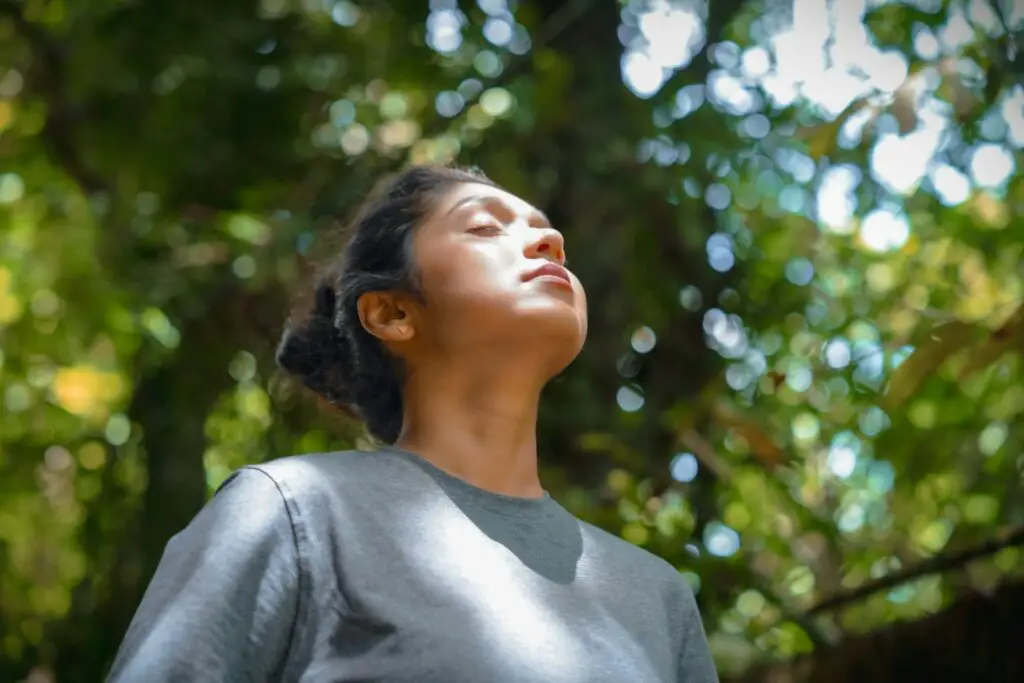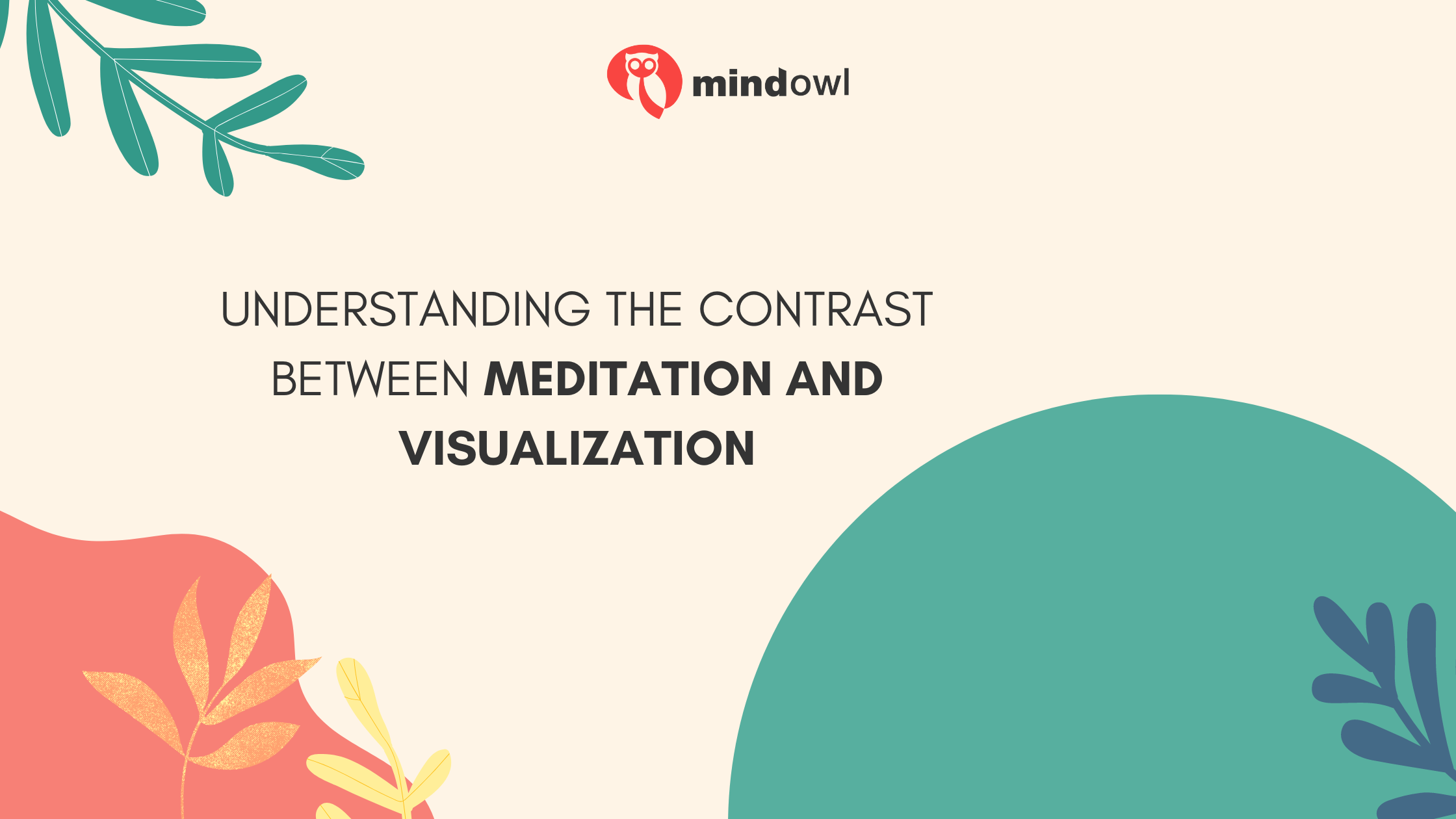Many people turn to practices like meditation and visualisation in hopes of calming the whirlwind inside their heads. But here’s an interesting fact: although often lumped together, these two approaches serve different parts of our mind and body.
This article will guide you through understanding these key differences, offering clarity on how each can play a unique role in managing stress and enhancing mindfulness. Ready for some peace of mind? Keep reading.
Key Takeaways
- Meditation focuses on calming the mind and connecting with the present, improving brain health and reducing stress.
- Visualisation uses mental imagery to create positive outcomes, activating the occipital lobe for enhanced mood and motivation.
- Techniques in meditation mostly involve breath work or mantras to achieve a restful state, while visualisation guides thoughts towards desired goals.
- Regular meditation leads to better handling of stress and increased calmness, whereas visualisation changes stress reactions into positive responses.
- Combining meditation and visualisation can offer a thorough approach to managing daily pressures and achieving personal objectives.
Definitions and Core Concepts
What is Meditation?
Meditation is a technique that focuses on self-awareness, helping individuals to observe themselves and their surroundings. It connects people with the present moment, away from distractions of past or future concerns.
Studies show that regular meditation practice strengthens connections between brain regions and boosts grey matter volume. This enhanced brain health leads to increased focus, better memory, and more creativity.
Researchers have found that meditation calms the nervous system, leading to significant stress relief. It allows the body to enter a state of deep rest which is essential for healing and recuperation from daily stresses.
Vedic meditation, in particular, grants access to a unique fourth state of consciousness—distinct from being awake, asleep, or dreaming—which aids in profound relaxation and mental clarity.
Meditation de-excites the nervous system and helps the body heal itself.
What is Visualisation?
Visualisation is all about using your mind and emotions to “see” and feel something in a very specific way. It’s like painting a picture in your head of what you want to happen or how you want to feel.
This method lights up the occipital lobe in your brain, which helps with seeing things even when your eyes are closed. When you visualise, you’re not just daydreaming; it’s more focused than that.
You guide your breath and thoughts towards a certain goal or outcome, making it an active process.
This tool is powerful for managing stress, boosting confidence before big events like public speaking or first dates, and reprogramming old fears into positive vibes. For example, guided imagery can transport you to a serene place in nature, complete with the sound of a cool breeze—all from the comfort of where you sit fully awake.
Visualisation isn’t just wishing for something good; it’s mentally setting yourself up for success by stirring up positive emotions such as joy or calmness.

Key Differences Between Meditation and Visualisation
Focus and Intent
In meditation, the goal is to rest deeply. You don’t try to control your breath or thoughts. This helps your body heal from stress. It’s like letting your mind float in a calm sea, away from the noise of everyday life.
Meditation takes you through different states beyond just being awake, asleep, or dreaming.
Visualisation has a more active aim. You guide your breath and thoughts towards what you want to feel or achieve—whether it’s a certain mood, mindset, or sensation in the body. It’s like using your imagination to paint your best scenario in bright colours.
Visualisation turns on the occipital lobe part of the brain that lets us see images when we close our eyes and dream up situations.

Techniques and Practices
Meditation uses simple practices like focusing on breath work or repeating a mantra to calm the mind. You sit quietly and pay attention to your breathing, feelings, or a specific phrase.
This helps reduce stress and brings you into the present moment. People often use zivaONLINE to learn these methods in just 15 days.
Visualisation involves using your imagination to create mental images of what you desire. For example, Veraki’s Chief Content Officer leads with guided visualisations that gently flow into meditation sessions.
This technique encourages high performance and better sleep by picturing positive outcomes before they happen. Whether it’s envisioning success in big life events or managing stress more effectively, visualisation turns goals into vivid scenarios.
Outcomes and Benefits
Practising meditation calms the nervous system, leading to deep rest and calmness. This means you will feel more at peace and balance in life. Visualisation, on the other hand, can change old stress reactions into a “stay and play” mindset.
Imagine facing stress with a smile instead of panic; that’s what visualisation helps you achieve.
People who meditate regularly find they are less upset by small problems. They handle big issues with more ease too. Using visualisation lets individuals reprogram their response to stress – turning fight-or-flight into confidence and control.
These practices not only improve your mental health but also strengthen your immune system, making you healthier overall.
Conclusion
Understanding the differences between meditation and visualisation can truly change how you tackle stress. Each has its own path—meditation quiets your mind, letting your body heal from daily pressures.
Visualisation takes an active role, guiding your thoughts towards specific goals. Emily Fletcher’s Ziva Meditation brings these practices into the modern world, making them easy for everyone to learn.
If you want to calm down or find a new way of reaching your dreams, combining both could be the key. They’re not just exercises; they’re tools that shape a better life.
FAQs
1. What’s the big deal about meditation and visualisation?
Meditation is like sitting quietly, focusing on your breath or a single thought to calm down. Visualisation, though, is when you use your imagination to picture a specific scene or goal. Both can help you chill out but in different ways.
2. Can visualisation really change how I feel?
Yes! Visualisation can trick your brain into thinking it’s experiencing something for real. This can shift you from stressed-out mode to feeling more relaxed and happy. It’s like imagining biting a lemon – you might actually pucker up!
3. How do professional athletes use visualisation?
Athletes often close their eyes and imagine themselves winning races or scoring goals before the actual event. This practice boosts their confidence and helps them perform better when it counts.
4. Is there a type of meditation that includes visualisation?
Actually, yes! Visualisation meditation combines both practices by guiding you through peaceful scenes in your mind while keeping you focused and relaxed – think lying on a sunny beach without leaving your room.
5: Why do some people prefer meditation over visualisation?
Some folks find that just meditating – focusing inwardly without any specific mental images – helps them reach a deeper level of relaxation than trying to visualise does. It’s all about what works best for each person.
6: Do these techniques help with real-life problems, like at work or school?
Absolutely! Whether it’s dealing with stress from deadlines or calming nerves before exams, both meditation and visualisation offer handy tools for tackling tough situations more calmly and confidently.
References
- https://www.ncbi.nlm.nih.gov/pmc/articles/PMC8832115/
- https://www.ncbi.nlm.nih.gov/pmc/articles/PMC6803504/
- https://www.ncbi.nlm.nih.gov/pmc/articles/PMC7003166/
- https://www.mindbodygreen.com/articles/difference-between-meditation-visualization
- https://www.ncbi.nlm.nih.gov/pmc/articles/PMC7287297/
MindOwl Founder – My own struggles in life have led me to this path of understanding the human condition. I graduated with a bachelor’s degree in philosophy before completing a master’s degree in psychology at Regent’s University London. I then completed a postgraduate diploma in philosophical counselling before being trained in ACT (Acceptance and commitment therapy).
I’ve spent the last eight years studying the encounter of meditative practices with modern psychology.


